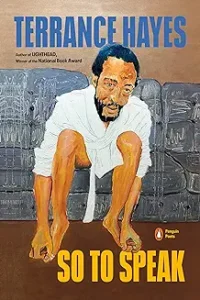So to Speak by Terrance Hayes 2023
Hayes is an NYU professor and a MacArthur and National Book award winner who is considered one of today’s leading poets.
This book was not an easy one for me to read or review. My taste in poetry runs to the traditional American poets of the 20th C—Donald Hall, Stanley Kunitz, Kay Ryan, Elizabeth Bishop, et al—and Hayes writes quite differently. He, himself, describes his poems as trying to emulate music and create a new language.
Many of his poems echo the message in the recently read ‘Notes of a Native Son’ by James Baldwin, describing the tenuous hold Blacks have on their lives in today’s America. In his poem, ‘Another Ravager of the Crops Was the Boll Weevil’, Hayes writes “Solace, survival, multiple genres of longing. I remember how/Seeing a white woman walking alone a few steps ahead of me//One night scared me so much I slowed down & cast a harmless/Old song into evening. Sometimes even at a distance,//I know what unsettles my country can also unsettle me./Sometimes fear tells us exactly where we are heading.”
The most interesting works in this volume are Hayes’ playing with the sestina form. The sestina ‘concocted by a French troubador in the 12th C’, is a 39 line poem that repeats six end words (teleutons) in six six-line stanzas in an interlocking cycle, and ends with a seventh, three line stanza (an envoy that uses all six teleutons.). Hayes writes that the “sestina’s numerological architecture and lexical repetition create a lyrical, potentially alchemical energy.” He then sets up a Do It Yourself grid with various teleutons and gears allowing the reader to create his/her own sestina. All very creative and entertaining.
A review of this collection in The Harvard Review stated that ‘So to Speak’ demonstrates Hayes’ restlessly innovative talent. Beyond inventing his own structures, Hayes enriches traditional poetic forms by subverting their historic associations with exclusionary norms of race and class. Hayes’s usual themes are all here: the problems of racial and sexual self-representation, the burdens of family and political history, the quirky revelations and limits of language itself—but in So to Speak his bravura and playfulness are tempered by undercurrents of sober self-reflection.
The cover features a painting of Marvin Gaye by Hayes. It’s a startling and effective intro to this book which is filled with gems, but one has to be persistent in reading the book in order to find them.



